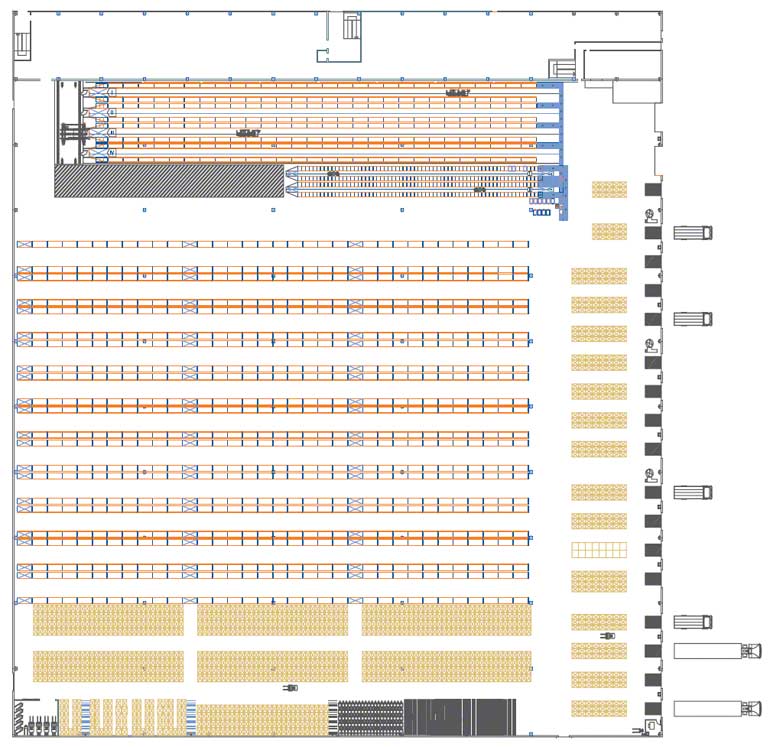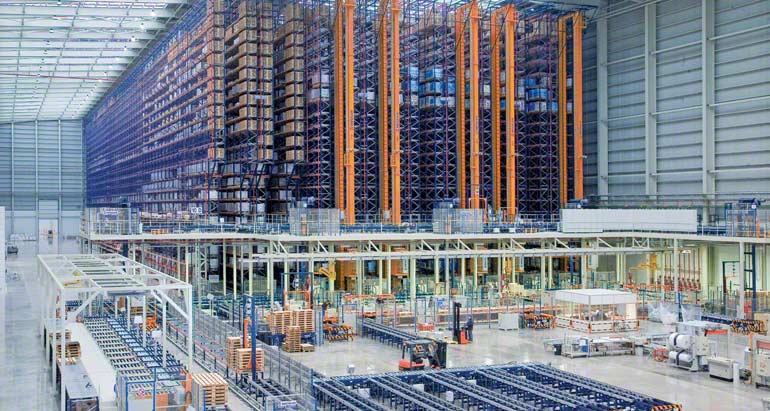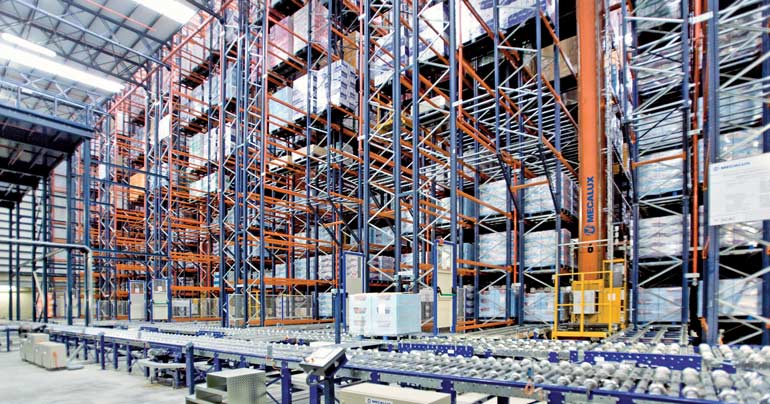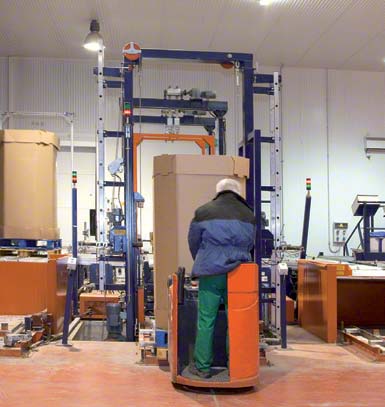Choosing between the various storage systems for each customer's needs is a process that includes numerous aspects. In this article it analyzes some basic criteria, since by understanding how these affect a final decision will make it easier to later analyze other more complex criteria.
There are four basic issues:
- The capacity to be obtained.
- The speed to be reached.
- The variety and type of products to be stored
- The general cost of the solution.
The following is an explanation of how each of these will condition the planning of the facility.

Installation with a combined storage system.
Capacity to be obtained
The "Selective pallet racking systems" section, which discussed storing pallets on racking units, highlighted the potential capacity to be achieved with each of the possible systems. There, it showed that compact systems offer greater storage capacity or, in other words, the same available surface area can house a larger number of goods.
At this point it is important to remember the issue discussed in the "A comparison of pallet rack capacity" article concerning physical and effective capacities, since with high-density systems there can be significant differences between the two, owing to the large number of empty spaces that can exist in a normal workflow.
Pallet racking units, in contrast, offer lower physical capacity than their compact counterparts. Yet as long as the right management system is used this physical capacity is very similar to effective capacity, since there are almost no empty spaces in the standard workflow.
Maximum effective capacity in a pallet warehouse is obtained by using a system that combines the best features of these two options, namely selective pallet racks on mobile bases. With this system, as long as a competent management system is employed then high physical capacity is achieved, similar to that reached with compact solutions, plus effective capacity that is very close to physical capacity.

Warehouse of a company selling floor and wall tiles.
In addition to making the most of the warehouse’s available surface area, the solution must also take into account the available vertical space. To this end, as long as the regulations so allow, it is helpful to use systems that make use of the full height of the facility or to build tall automated warehouses (as illustrated in the image above)..
Desired speed
Often, it is essential to minimize the time spent performing operations in the warehouse, particularly if the installation is medium or large in size. The number of operators required is directly related to this factor and, as a result, so is the added cost for each operation performed.
To measure the time taken to perform each task, one must calculate the time spent covering the distance between the initial point and the point where the goods are stored and add this to the time taken to return to the starting point. The exception is a combined movement (taking advantage of the journey to collect some goods to leave other goods, or vice versa); in which case, these times are measured separately.
When analyzing the different operations, for goods on pallets the slowest and least dynamic system is the drive-in racking system, followed by push-back racks. The fastest option is gravity-flow racking, followed by a system based on selective pallet racks. Between these two extremes are the mobile base and Pallet Shuttle solutions, but the results of these depends on the number of consecutive operations carried out in each lane.
AS/RS installations, for their part, are quick if tasks are properly programmed.
Product variety and type
With this factor, the suitability of the chosen solution depends on the range of SKUs, the number of pallets or boxes per product, and the time the goods will spend in the warehouse.
If the goods are on pallets, there is a wide range of SKUs, and there are few pallets of each of these, the ideal system is static pallet racking units. However, another very good option is to install these on mobile bases.
In the opposite situation, where there are few SKUs and lots of pallets of each of these, any compact system is optimal. If, in addition, the goods are going to spend a great deal of time without being moved, drive-in racking is also ideal.
When the goods to be stored are handled in boxes or loose items in specific positions, individual storage and loose product solutions can be used, except when the products are of an irregular shape.
In addition to these considerations, another factor that determines the system to be used is rotation. Thus, any storage system can be used for rotation A products (high consumption) on pallets, but high-density systems are particularly appropriate. It is common to use these systems with such products; however, one must not forget the greater time required to perform maneuvers.
In terms of B products (medium consumption), the ideal options are those that use selective pallet racks, push-back racks, and shallow flow racking units.
General cost
The fourth factor to be considered when choosing a storage option is its set-up and operating costs. Its ultimate purpose is to help generate company business. For the company to be competitive, operational costs must be as low as possible.
It is also important to estimate the period required to generate a return on investment (ROI), which must also be as short as possible. Some companies have a policy of not undertaking investments which have a ROI of more than three years.
As a result, in most cases the solution chosen will be that which offers the most competitive price and the shortest period required to obtain a return on the investment. In addition, the customer must be capable of financing the chosen solution.
While the choice of the appropriate storage system, adequate flows, operating method, warehouse location, etc. all have significant repercussions on the financial performance of the warehouse, the factor that will have the biggest impact on this performance is the solution chosen for the picking or preparation of orders (the operating methods of which are explained below).
The tables below show a comparison of the different pallet racking solutions, although it only includes the factors with the greatest influence. The final score is merely intended as a measure of the scale of the advantages and disadvantages of the different systems; it does not imply that the system with the highest score is always the best. In each case, one system will be better suited than another. In formulating this comparison, no consideration has been given to picking operations, only an assessment of the storage of pallets, accessibility, and capacity.
| STORAGE SYSTEM COMPARISON TABLE |
| Direct access storage systems |
| |
Selective pallet racks
|
Mobile bases |
Double-deep pallet racks |
VNA pallet racks |
AS/RS for pallets |
Double-deep AS/RS for pallets |
|
Use of surface area
|
2 |
5 |
3 |
3 |
3 |
4 |
|
Use of volume
|
2 |
4 |
3 |
3 |
3 |
3 |
| Access to any pallet |
5 |
5 |
2 |
5 |
5 |
4(A) |
Speed of
access/agility
(movements
per hour) |
4 |
3 |
2(B) |
3 |
5(C) |
4(A) |
| Stock rotation |
4(D) |
4(D) |
2(B) |
4(D) |
5 |
4(A) |
| FIFO |
FIFO |
FIFO (relative) |
FIFO |
FIFO |
FIFO (relative) |
| Height of top level (ft) |
2 |
2 |
1 |
3 |
5 |
4 |
| <32.8 |
<32.8 |
<26.2 |
<45.9 |
<147.6 |
<131.2 |
| Aisle width (ft) |
3 |
2 |
3 |
4 |
5 |
5 |
| 7.2/11.5 (E) |
9.8/11.5 (E) |
9.8 (E) |
5.08/5.9 (F) |
5.08 |
5.08 |
| Initial investment |
4 (low) |
3 (medium) |
4 (low) |
3 (medium) |
2 (high) |
2 (high) |
| Handling equipment (forklift) |
·Stacker
·Reach truck
·Counterbalanced forklift
|
·Reach truck
·Counterbalanced forklift
|
·Custom reach truck
|
·Trilateral VNA
·Bilateral VNA
|
·Stacker crane |
·Stacker crane |
| Advantages (average score)* |
3.25 |
3.50 |
2.50 |
3.50 |
4.12 |
3.75 |
| HIGH-DENSITY STORAGE SYSTEMS |
| Compact storage systems |
| |
Drive-in pallet racks
|
Push-back with trolleys |
Push-back with rollers |
Pallet Shuttle |
Flow racks with rollers |
Automated Pallet Shuttle
|
Automated flow racks with rollers |
| Use of surface area |
5 |
4 |
4 |
5 |
5 |
5 |
5 |
|
Use of volume
|
5 |
4 |
4 |
4 |
4 |
4 |
4 |
| Access to any pallet |
1 |
2 |
2 |
1 |
2 |
2 |
2 |
| Speed of access/agility (movements per hour) |
2 |
3 |
3 |
3 |
4 |
4 |
5 |
| Stock rotation |
1 |
2 |
2 |
2 |
5 |
2 |
5 |
| LIFO |
LIFO |
LIFO |
LIFO |
FIFO |
LIFO |
FIFO |
| Height of top level (ft) |
2 |
1 |
1 |
2 |
3 |
3 |
4 |
| <32.8 |
<24.6 |
<24.6 |
<32.8 (E) |
<45.9 (E) |
<131.2 |
<131.2 (G) |
| Aisle width (ft) |
2 |
2 |
2 |
2 |
3 |
4 |
4 |
| 9.8/11.5 (H) |
9.8/11.5 (H) |
9.8/11.5 (H) |
9.8/11.5 (H) |
5.9/11.5 (H) |
5.08 |
5.08 |
| Initial investment |
4 (low) |
3 (medium) |
3 (medium) |
3 (medium) |
2 (high) |
2 (high) |
1 (very high) |
| Handling equipment (forklift) |
·Reach truck
·Counterbalanced forklift
|
·Reach truck
·Counterbalanced forklift
|
·Reach truck
·Counterbalanced forklift
|
·Reach truck
·Counterbalanced forklift
·Trilateral VNA
|
·Reach truck
·Counterbalanced forklift
·Trilateral VNA
|
·Stacker crane |
·Stacker crane |
| Advantages (average score)* |
2.75 |
2.62 |
2.62 |
2.75 |
3.50 |
3.40 |
3.75 |
SCORE: 1 (low) to 6 (very high). For “initial investment”, the values are reversed.
* Average obtained from the eight numerical variables.
(A) With WMS and relocation bay
(B) With WMS and A-B-C management can be greater
(C) Programmed operation
(D) With suitable WMS
(E) Depends on the forklift
(F) Depends on whether it is bilateral or trilateral
(G) It is vital to ensure the pallets are of good quality
(H) Depends on the forklift and simultaneity in an aisle
Combination of factors
It is common to find installations where a number of the factors described above have been taken into account. It is also normal to use several storage systems, each for a specific type of product.
We have already seen some examples, such as in the "
Combined storage systems " article, in which pallet racking units are combined with racking units on mobile bases, drive-in pallet racking units, flow rack systems and, in addition, roller conveyors to reduce maneuvering times.
The combination of factors and storage solutions allows unique facilities to be created that are best adapted to the specific needs of the companies that operate them.
Optimization of the factors in AS/RS warehouses
The tables above show that AS/RS (automated storage and retrieval systems) combine the optimization of basic criteria. The only problem here is their higher initial cost. However, they provide significant advantages, such as their large storage capacity, greater construction height, perfect control and management, high performance at points of entry and exit (these are totally automated), a minimal requirement for personnel, greater accessibility to products, easier rotation, etc.

Warehouse of a cosmetics distribution company.
Automated systems can be used just to position goods, for internal transportation, or both. The latter is most common, since it considerably increases the number of movements that can be carried out and, in addition, operators only have to load and unload the trucks or containers.
Fully automated AS/RS solutions have suitable conveyors installed in the dock areas. In general, these conveyors are configured to operate with stacker cranes. This system is used in both exit and entry areas, but for entry areas gauge and pallet control elements must be fitted to guarantee the smooth running of the automated machines and devices.

Checkpoint entrance in an automated warehouse.

AS/RS for pallets.





